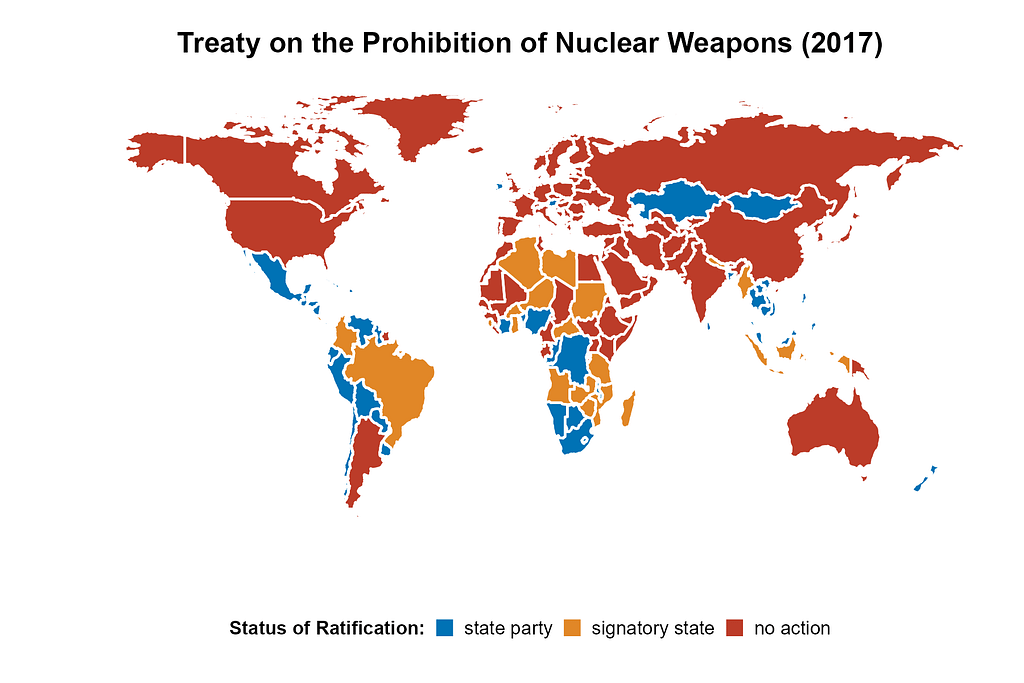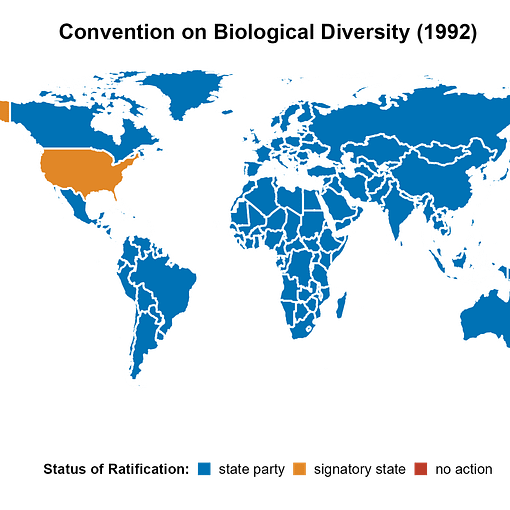This post examines the current ratification status of the Treaty on the Prohibition of Nuclear Weapons (TPNW), which was opened for signature on September 20, 2017. Presently, there are 93 signatory states, of which 70 have become state parties to the treaty. Notably, the TPNW stands as the first legally binding instrument specifically addressing nuclear weapons, encompassing their use, development, and transfer.
The genesis of the treaty negotiations stemmed from a General Assembly resolution that called for a Conference aimed at crafting a legally binding instrument for the elimination of nuclear weapons. This pivotal conference convened in New York, resulting in the adoption of the treaty on July 7, 2017.
Utilizing data from the United Nations Treaty Collection’s website, we mapped the current ratification status of the TPNW, classifying UN member states into three categories: states that have not taken any action, signatory states that have not ratified the convention, and states parties that have ratified it.

Analyzing the ratification status of the Treaty on the Prohibition of Nuclear Weapons (TPNW) yields intriguing insights. Primarily, the majority of signatories and state parties hail from the Global South. Notably, except for South Africa, none of these nations known to possess nuclear capabilities have signed or ratified the treaty. Additionally, no member countries of NATO have endorsed the treaty, as the organization has taken a firm stance against it. Consequently, the treaty’s efficacy is considerably diminished, as key players in nuclear weaponry development and potential utilization abstain from participation.
The TPNW stands as a comprehensive treaty, underscored by several preambulatory clauses emphasizing the imperative of eliminating nuclear weapons. It unequivocally assigns all states the responsibility to prevent any deployment of nuclear armaments. Crucially, the treaty’s operational clauses encompass a spectrum of nuclear-related issues. Article 1, for instance, proscribes the development, manufacture, and acquisition of nuclear weapons, along with prohibitions on atomic weapons testing and weapon ownership transfer. Notably, Clause (g) of Article 1 prohibits the “stationing, installation, or deployment” of such weapons in the territories under the jurisdiction of any state party. Moreover, the TPNW explicitly outlaws the threat of nuclear weapon use.
Monitoring adherence to treaty stipulations hinges on countries’ willingness to disclose their nuclear arsenals or storage within their borders. However, since current state parties did not initially possess nuclear stockpiles, evaluating their effectiveness remains challenging. South Africa, the sole state party with prior nuclear capabilities, is subject to a specific treaty article mandating the declaration of any past atomic weapon possession and programs, alongside the elimination of such arsenals and associated facilities.
In summary, the Treaty on the Prohibition of Nuclear Weapons, albeit making gradual headway, constitutes a significant milestone in the disarmament endeavor. As the inaugural legally binding instrument prohibiting nuclear weapon usage, the treaty acknowledges the catastrophic consequences of their deployment and development. It serves as a foundational stepping stone, fostering further strides and activism towards disarmament.
About the authors:
Alex Dunton is a Junior at Drew University majoring in International Relations.
Júlia Oliveira Souza is a senior at Drew University majoring in International Relations and Spanish.
Editor’s note: This entry was written for Drew University’s PSCI 329 Principles of International Law course.

